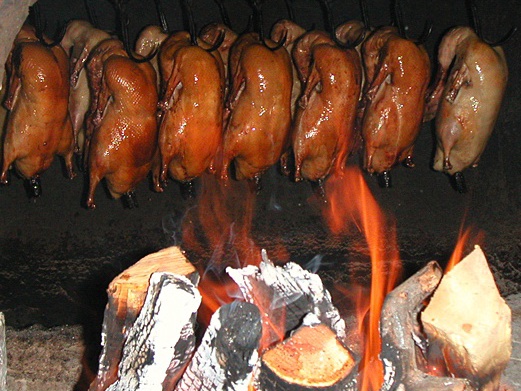As one of the most delicious dishes all over the world, no tourist will take the risk of missing the Beijing Duck when touring in Beijing. Slow roasted and succulent, this famous dish is served with thin crepe-like "lotus leaf pancakes" (heye bing), sweet noodle sauce (tianmianjiang) or hoisin sauce (haixianjiang) and finely sliced green onions. Often an adept chef slices the freshly roast duck table-side before serving, separating the skin from the meat. Once served, the meat is wrapped in a pancake with all the fixings and quickly enjoyed.

The history of the roast duck can be traced back to as early as the Yuan Dynasty (1206-1368) when it was listed among the imperial dishes in the Complete Recipes for Dishes and Beverages. In the early 15th century of the Ming Dynasty, Beijing roast duck remained one of the famous dishes on imperial court menus. According to the local history, the earliest roast duck restaurant in Beijing was the old Bianyifang Restaurant, which opened during the Jiajing reign (1522-1566). Distinct from the method in which the duck is hung from a hook in the ceiling of the oven and roasted over and roasted over burning wood, the Old Bianyifang Restaurant roasted its ducks with radiant heat. The walls of the oven were first heated with sorghum stalks whereupon the duck was placed inside and cooked by the heat given off by the walls. A duck roasted in this manner is crisp to the touch and golden brown in appearance; its flesh is both tender and tasty.
During the Qianlong period (1736-1796), roast duck was a favorite delicacy of the upper classes. According to Recipes from the Suiyuan Garden, the famous cookbook written by the poet and gourmet Yuan Mei, "Roast duck is prepared by revolving a young duckling on a spit in an oven. The chefs of Inspector Feng's family excel in preparing this dish." Other scholars, after dining on roast duck, were inspired to poetry. In one collection of old Beijing rhymes (Duan Zhuzhici) one of the poems reads: "Fill your plates with roast duck and suckling pig." Another contemporary annotation reads: "When an official gives a banquet he will choose dishes to please each of his guests. For example, Bianyifang's roast duck"
To satisfy the growing demand for roast duck, and with an eye on the profits to be made from a good name, many restaurants opened from a good name, many restaurants opened under the Bianyifang name. In fact, in 1926, nine roast duck restaurants in Beijing carried this name. In the late 1960s the Bianyifang Restaurant's name was changed to the Chongwenmen Roast Duck Restaurant, but in 1979 it resumed its former title. Its menu includes more than 20 traditional duck dishes, including the Four Delicacies: wing and web, liver, heart and pancreas.
A proper way to eat Beijing Roast Duck can be divided into 3 steps. First, pick up a slice of duck with the help of a pair of chopsticks and dip it into the soy paste. Next, lay it on the top of a thin cake and add some bars of cucumber and shallot. Finally, wrap the stuff into a
Roast Duck
bundle with the sheet cake (a thin pancake). The real secret of Peking duck's flavor lies in your carefully nibbling away at the mixture. You will find all the different ingredients very compatible. People say: "it's a pity to leave Beijing without trying the roast duck. The taste of the roast duck is in the eating.
Quanjude RestaurantThe Quanjude Restaurant, the largest roast duck restaurant in Beijing if not in the world, opened for business in 1979. Located near Hepingmen Gate (Peace Gate), it has a floor space of 15,000 square meters divided into 41 dining halls, including one, which can serve 600 customers simultaneously. The dining halls reserved for overseas guests can accommodate a total of 2,000 diners, and include a hall where all-duck banquets in which all the dishes are made from parts of the duck can be served to 600 people. Filled to capacity, Quanjude Restaurant can serve as many as 5,000 meals a day.



